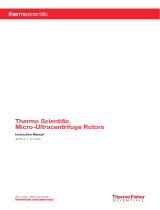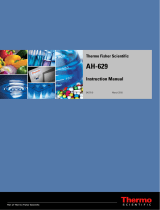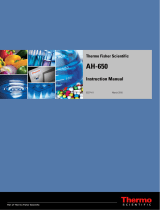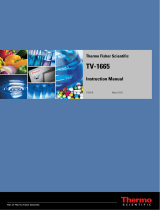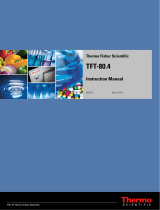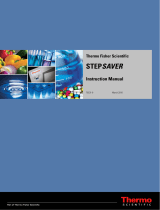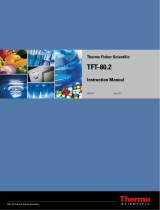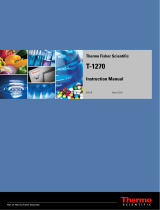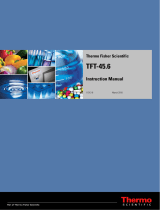Page is loading ...

Continuous Flow Rotor
TCF-32
Instruction Manual english
Analyze • Detect • Measure • Control™
The original copy of this manual is
valid. Thermo Scientific cannot
guarantee the accuracy or
completeness of subsequent copies.

CONTENTS
1. PREFACE ································································································································3
2. SPECIFICATIONS·····················································································································3
3. COMPOSITION·························································································································4
4. USAGE ··································································································································11
4.1 General description on usage ·························································································11
4.2 Usage·······························································································································12
4.3 Capacity in rotor ·············································································································25
4.4 Determination of sample flow rate····················································································26
4.5 Lubricating unit ············································································································· 26
5. PRECAUTIONS IN USING ROTOR······················································································ 28
6. TROUBLE SHOOTING ········································································································· 31
7. LIFE AND WARRANTY OF ROTOR····················································································· 33
8. WARRANTY OF LUBRICATING UNIT AND SEAL ATTACHMENT ASSEMBLY··················· 34
9. MAINTENANCE ······················································································································35
10. SEPARATION CHARACTERISTICS ··················································································· 38
11. COMPONENTS AND ACCESSORIES ················································································ 39
12. INSTRUCTION FOR 940ML CORE······················································································ 44
13. Preventive Maintenance ······································································································ 47

-1-
Precautions on Handling rotor
Do not spin a rotor beyond the allowable speed.
{ The maximum speed marked on a rotor refers to an allowable one when the maximum density
of the sample or density gradient solution is less than 1.2.
{ When a sample or density gradient solution of more than 1.2 in maximum density is used, the
maximum speed must be reduced according to the instruction manual for the rotor.
{ Upon reaching the end of the service life of a rotor specified in its instruction manual, the
allowable speed should be reduced by 10%.
Set a rotor gently and securely onto the drive shaft hub.
{ Practice setting repeatedly to acquire the knack.
Confirm that the rotor is free from corrosion and scores.
{ If white corrosion is recognized on a tube hole bottom of an angle rotor, or a hole bottom of a
bucket for swing rotor, immediately stop using it and contact the nearest agent of Thermo
Scientific.
{ When operation is over, store the rotor after cleaning and drying.
Make it a practice to keep a logbook for rotors.
{ Keeping a logbook for rotors is indispensable for controlling the life or when the warranty
clause is involved. Keep the logbook up to date and store it properly.

-2-
Do not rotate this rotor at a speed of more than 3,000 rpm unless all components (rotor
assembly, seal attachment assembly and lubricating unit assembly) are assembled.
Do not rotor at a speed of more than 3,000 rpm unless the rotor is filled with liquid.
If the above cautions are not observed, shaft (D) could be broken or the core could be
damaged.
Always ground the ultracentrifuge, Iubricating unit and low-temperature circulating chamber
before use.
Be sure to read article on 9. MAINTENANCE.

-3-
1. PREFACE
We have developed a continuous flow rotor which permits sizable processing with samples
allowed to flow continuously.
Utilize this continuous flow rotor of high performance and reliability for your studies or
processing
2. SPECIFICATIONS
Table 1 shows the specifications of this continuous flow rotor.
Table 1 Specifications
Type of Rotor TCF-32
Max. speed 32,000 RPM
Max. centrifugal force 101,685 X g
K factor 42
Total capacity 430 ml
Maximum flow rate 150 ml/min (9 l/hr)
Sample pH range PH 4~10
Maximum Dia. of rotor 24 cm
Supply power for lubricating unit AC 100-240V, 1A (50/60Hz)
NOTES
For operation of Model TCF-32, the following apparatus are required besides the standard
configurations of Model TCF-32 and Preparative Ultracentrifuge, which have to be prepared for
installation of Model TCF-32 at customer's site.
1. Sample Loading Pump
Specifications
Flow rate: Has to be as fast as operating flow rate required for separation of samples.
Exhaust pressure: More than 1.5kg/cm2.
Model without pulsating motion is recommended.
2. Low Temperature Circulating Water Cooling Bath
Cooling capacity: More than 300 Kcal/hr (water temp. at 5°C)
(Refrigerator: as strong as 300W)
Circulating Pump
Flow rate: More than 1 l/min. (pressure: 0.5-1 kg/cm2)
3. Density Gradient Pump
Required for density gradient separation.

-4-
3. COMPOSITION
Fig.1 shows the overall construction
Lubricant is supplied
to bearing
Fig.1 Overall construction
Lubricating unit
Ass’y
Seal Attachment
Ass’y
Rotor body ass’y
Sample outlet
Sample inlet
Water outlet
Oil discharged from
bearing is sucked
and recovered
Cooling water is
supplied
Oil outlet Oil inlet
Water inlet
Door adapter
Bearing
Bearing housing
Shaft (D)
Bearing housing
Seal body ass’y
Collar
Seal Door
Rotor

-5-
3.1 Rotor body assembly
(1) Rotor and cover
The rotor and cover are made of titanium alloy which is excellent in mechanical strength
and corrosion resistance, and is coated in black (see Fig.2)
(2) Core titanium sleeve and blades
All of them are introduced in the rotor. The core forms a passage of sample and density
gradient solution in the rotor. Its material is Noryl.
The titanium sleeve is for reinforcing the core, and is put on the outside of the core. It is
made of titanium alloy.
The blades are for preventing the sample and density gradient solution in the rotor from
whirling up. It is made of Noryl.
(see Fig. 3)
Fig. 2 Rotor body assembly Fig. 3 Core, titanium sleeve and blades
Core
Blade
Titanium sleeve

-6-
(3) Shaft (D) and Swagelok nut
The shaft (D) is made of titanium alloy. The section sliding with the bearing is coated with
molten tungsten carbide to improve the wear resistance.
The Swagelok nut is made of stainless steel. It fastens the shaft (D) on the cover (see Fig. 4)
Shaft (D) is a critical component. Be careful of handling it so that it is not bent, etc.
(4) Seal tube head and seal
The shaft area of seal tube head is inserted in the (polyphenylene oxide resin). shaft up to
the core, and serves as a passage for sample etc. It is fastened on the shaft with left hand
threads. The material is stainless steel. The seal is mounted on the top of the seal tube head.
It is an important component in charge of letting in and out sample, etc. to and from spinning
rotor. The employed material is polyimid resin whose sealability is excellent at a high
peripheral speed (see Fig. 5 and 6).
Fig. 4 Shaft (D) Fig. 5 Seal tube head Fig. 6 Seal

-7-
3.2 Seal attachment assembly
(1) Door adapter
It is screwed in the door of the ultracentrifuge, and supports the entire seal attachment
(see Fig. 7).
(2) Bearing housing
The bearing housing holds the bearing made of white metal, and is engaged with the rotor
shaft (D). It is supplied with lubricant and cooling water from the peripheral connector (see
Fig. 8).
Fig. 7 Door adapter Fig. 8 Bearing housing
(3) Seal body assembly, collar and screw sockets
The seal body assembly consists of seal piece which is in contact with the rotor seal and
transfers sample, etc., pipe, spring, manifold and connector. The seal body assembly is
pushed against the seal by the spring. As for materials, the seal piece is made of tungsten
carbide and others are made of stainless steel.
The collar which is made of stainless steel is put on the outside of the seal body assembly,
and seals the cooling water which cools the seal body assembly.
The screw sockets (A) and (B) fasten the seal body assembly and collar (see Fig. 9 and
10).

-8-
Fig. 9 Assembly of seal body Fig. 10 Seal body assembly
Assembly, collar and
Screw sockets
3.3 Lubricating unit assembly
The lubricating unit assembly is used when operating this continuous flow rotor.
The specification and operation procedure of this unit are as follows.
(1) Specification
Item Specification Remarks
1. Lubricating oil supply
flow rate 80 ± 20 ml/min l For the seal attachment
assembly lubrication
2. Drain suction
pressure 81 kPa (The pump simple
substance pressure).
l For the DRAIN collection
3. Malfunction detection l Lubricating oil flow detection
(The pressure detection
formula)
l Cooling water flow detection
(The pressure detection
formula)
l It is an extraordinary caution
when Lubricating oil doesn't
flow.
l It is an extraordinary caution
when cooling water doesn’t
flow.
4. Malfunction warning There is a warning in the
electronic buzzer.
5. The container The glass bottle of 500 ml
For lubricating oil and the waste
oil
6. Noise 60 dB (A scale) l 1 m of the front
7. Input power l Input power :
AC 100-240V, 50/60Hz
l Inner supply voltage :
DC 12V, 4.17A max.
l It uses AC adapter
8. Size 273 X 318 X 219
9. Weight 10.8 kg
Seal body
ass’y
Collar
Screw
socket (A)
Screw
socket (B)

-9-
(2) Function
Lubricating unit assembly works as follows.
l Supplies lubricating oil to seal attachment assy.
l Sucks and recovers waste oil discharged from the bearing
housing assembly.
l Detects a malfunction when there is trouble in the supply
of lubricating oil or cooling water.
l When this safety device activates, solve the problem
quickly.
(3) Operation and the maintenance
1) The lubricating unit assembly is mounted on the centrifuge .
2) The power of this unit is 100-240 V of single-phase AC.
Please, connect the plug of the AC adapter with it.
3) Supply lubricating oil (P/N 463152) to the OIL bottle for lubricating oil by about 400 ml.
Check lubricating oil quantity every time it uses.
If becoming below the half of the bottle, replenish.
4) The switch of the control panel has the following function.
l The OIL switch is the ON-OFF switch of the lubricating oil pump.
Also, it is the ON-OFF switch of the lubricating oil flow abnormal detection equipment.
When the flow of lubricating oil stops, it informs in the buzzer sound.
When making this switch OFF, the buzzer sound stops.
l The WATER switch is the ON-OFF switch of the cooling water flow abnormal detection
equipment. When the flow of cooling water stops, it informs in the buzzer sound.
When making this switch OFF, the buzzer sound stops.
l The DRAIN switch is the ON-OFF switch of the waste oil suction pump.
l Please check the waste oil quantity of the DRAIN bottle after operation.
The operation procedure of each switch is being explained at this instruction manual.
When operating a rotor, operate according to them.
Fig.11 Lubricating unit

-10-
3.4 Tools and accessories
Applications of the tools and accessories are enumerated below:
Table 2
PARTS NAME USE
a. Rotor base tightens and removes rotor cover
b. Handle tightens and removes rotor cover
c. Torque wrench installs and removes shaft
d. Handle installs and removes door adapter
e. Screwdriver fastens bearing housing
f. Stopper (B) prevents bearing housing from rotating
g. Seal tube head setter tightens and removes seal tube head
h. Seal extractor detaches seal
i. Core setter extracts core
j. Pressure gage supervises sample injection pressure
k. Clamp changes over pipe passage
l. Watchmaker’ s screwdriver removes O-ring
m.
Silicone grease maintains rotor body
n. Lubricant for screw lubricates screw
o. Rotor stand rotor storing stand
Fig. 12 Tools and accessories

-11-
4. USAGE
4.1 General description on usage
The continuous flow rotor is employed in the following manner :
Table 3 Separation procedure
Procedure
Item
Injection of density
gradient solution, buffer
solution Centrifugal separation Recovery
Solution flow
Spinning speed 3,000 rpm Specified speed 3,000 rpm
Density gradient
centrifugation Inject density gradient
solutions from lighter
ones
Inject high density
extrusion solution, and
recover separated
solution
Pelleting Inject buffer solution
Continuously inject
sample at specified flow
rate Stop and disassemble
rotor, and recover
CAUTION : This rotor should never be spinned at a speed over 3,000 rpm unless all the parts such
as rotor assembly, seal attachment assembly and lubricating unit assembly are mounted in
place and also with the rotor not filled with the liquid.
If these cautions are not observed, shaft (D) could be broken or the core could be damaged.

-12-
4.2 Usage
n Be careful of the following to separate the sample at low temperatures.
¡ Assemble the rotor body assembly and precool it in a low-temperature chamber, etc.
¡ Inject the cooled buffer solution and density gradient solution.
¡ Precool the sample and inject it while cooling the sample container using ice or in a
low-temperature chamber, etc. during separation.
4.2. 1 Preparation of rotor
1
Install the seal packing and metal ring on the
rotor. Also mount the O-ring on the boss on the
rotor bottom.
¡ Make sure the seal packing, O-ring, etc. are
free from scratches, and apply a thin coat of
vacuum grease on them.
¡ For installation of the seal packing and metal
ring, refer to the magnified figure.
¡ Make sure the rotor and cover are free from
cracks or the like which is a symptom of
material fatigue.
Warning: Do not remove the overspeed adapter
(stripe ring mounted on rotor bottom).
Caution: Since O-ring and seal packing which are
used in the rotor or the connecting portion of the
seal section will come into contact with sample,
always rinse them before use.
When these parts are replaced, some residue
generated when rubber was formed may remain on
the surfaces of new parts:
Rinse them away before use.
O-ring (1AS22)
Metal ring
Seal packing
Metal ring
Seal packing
Rotor
O-ring (1AS22)

-13-
2
Mount the core, titanium sleeve and blades.
¡ Make sure the three types of O-ring are free
from scratches. Apply a thin coat of vacuum
grease on them before installation.
¡ Put the blades on the pins on titanium sleeve.
¡ Position the sample outlet hole in the core and
the titanium sleeve in relation to each other as
shown below.
3
Introduce in the rotor the assembly of core,
titanium sleeve and blades.
Sample outlet hole
Sample inlet hole
Blade
Blade
Titanium
sleeve
O
-
ring
(1AP135)
O
-
ring
(1AG145)
O
-
ring
(1AF3)
Core

-14-
4
Mount the rotor on the Rotor base, put on the
cover, and tighten by the furnished handle.
¡ Tighten the cover above the match point (see
right figure) of the match marks of rotor and
cover.
5
Insert the shaft (D) assembly
into the hole located at the
center of the cover.
¡ Make sure the O-rings are
free from scratches, and
apply a thin coat of
vacuum grease on them.
¡ The shaft (D) can be
introduced 15 mm in the
cover. Put it in until it is
held against.
¡ Two O-rings are used, on
the top and bottom ends of
the shaft (D).
6
Sufficiently tighten the swageloknut until the
clutch of the torque wrench functions.
¡ It functions at 5 N?m {51kgf?cm}.
Nut
Match mark
Shaft (D)
O
-
ring
stopper
O
-
ring
(1AP4)
O
-
ring
(1AS5)
O
-
ring
stopper
O
-
ring
(1AP4)
Nut

-15-
4.2.2 Preparation for spinning
1
Remove the door hole cover of the
ultracentrifuge , turn on the POWER switch, and
open the door.
¡ To remove the door hole cover, use the door
hole adapter handle.
2
Install the rotor gently on the spin shaft.
3
Close the door.
¡ Apply a thin coat of vacuum grease on the door
seal O-ring, and mount it back in position.
O-ring

-16-
4
Mount the door adapter.
¡ Use the handle and screw in clockwise to
mount.
Tighten until the O-ring is compressed enough.
¡ Check that shaft (D) of the rotor is positioned
approximately at the center of the center hole of
the door adapter.
If the eccentricity is too great, the door may
have been set to the incorrect position. Return
to step 3 and close the door firmly.
5
By means of the furnished screwdriver, loosen
2-3 turns six setscrews for stopper (A) of door
adapter.
Screwdriver
Shaft (D)
Stopper (A)

-17-
6
Connect the cooling water tube, oil circulation
tube and waste oil (drain) to the bearing housing.
Refer to the figure below for connections.
7
Put the bearing housing gently on the rotor shaft
until the bottom surface of the bearing housing
touches the door adapter. Then turn about 60°to
engage the stopper with the door adapter in such
manner that the water passage faces the rear of the
centrifuge.
8
Position the bearing housing stopper (B) which
prevents the bearing housing from turning in the
gap between the bearing housing and door adapter.
Water
passage
a. Connect to OIL IN
Stopper (B)
b. Connect to
DRAIN IN
c. Connect to WATER OUT d. Connect to OIL OUT
e. Hole for water passage
Centrifuge front

-18-
9 1) Turn on the OIL switch of the lubricating unit. Lubricant will circulate. (If the buzzer sounds
and the TROUBLE lamp has lit, the oil level in the oil tank is poor or the pump is faulty.)
2) Set the operation mode to ZONAL, set the speed to 1,000 rpm, and press the start switch to
start the rotor.
If an abnormal sound is heard or abnormal vibrations occur during acceleration,
release the ZONAL mode immediately to slow down the rotor. Inspect the assembled
state of the bearing housing and rotor shaft and the bending of the shaft, and correct If
required.
3) When the rotor attains a speed of more than 950 rpm, turn on the VACUUM switch to
vacuumize the rotor chamber.
4) After 30~60 seconds, cancel the ZONAL mode and stop the rotor.
10
Using the screwdriver, tighten the six stopper
(A) setscrew loosened in 5.
11
Insert the seal tube head on the shaft and,
using the furnished seal tube head setter, tighten it
by rotating counterclockwise (left hand threads)
until the rotor turns together. Thus tightening has
been completed.
Seal tube
head
Seal tube
head setter
/
